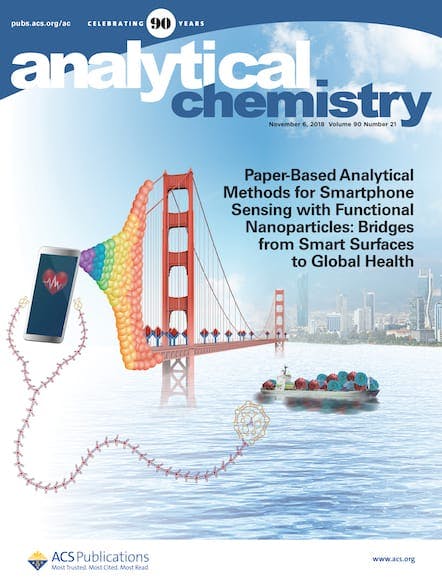Professor Keisuke Goda, a Professor in the Department of Chemistry at the University of Tokyo and an Adjunct Professor in the Institute of Technological Sciences at Wuhan University, is this year’s recipient of the Analytical Chemistry Young Innovator Award. The award honors the contributions of an individual who has demonstrated exceptional technical advancement and innovation […]

Professor Keisuke Goda, a Professor in the Department of Chemistry at the University of Tokyo and an Adjunct Professor in the Institute of Technological Sciences at Wuhan University, is this year’s recipient of the Analytical Chemistry Young Innovator Award. The award honors the contributions of an individual who has demonstrated exceptional technical advancement and innovation in the field of microfluidics or nanofluidics in his or her early career. Analytical Chemistry and The Chemical and Biological Microsystems Society (CBMS) co-sponsor the award.
“Professor Keisuke Goda’s research fuses microfluidics and photonics to create unique devices and approaches that enable a range of scientific advances,” says Analytical Chemistry Editor-in-Chief Jonathan V. Sweedler. “His interdisciplinary contributions to high throughput cell sorting integrate advances in optics, fluidics, and deep learning to enable fast and precise cell sorting. He is highly deserving of being the next Analytical Chemistry Young Innovator.”
A Look at Professor Keisuke Goda’s Career
During his graduate study in the LIGO group at MIT and CalTech, Professor Goda worked on the development of gravitational-wave detectors, which led to the 2017 Nobel Prize in physics. From there, he expanded his expertise precision measurement to optical imaging and microfluidics to demonstrate ultrafast imaging and high-throughput imaging flow cytometry.
In 2012, he became a professor at the University of Tokyo, where he built a research group focused on the development of serendipitous-enabling technologies based on molecular imaging and spectroscopy together with microfluidics and computational analytics.
In 2018, his group and colleagues developed the “intelligent image-activated cell sorting” technology that performs real-time image-based sorting of single live cells on a microfluidic platform with the help of a convolutional neural network.
As the 2019 Analytical Chemistry Young Innovator Award winner, Professor Keisuke Goda will receive a $2,500 honorarium and $1,500 in travel and accommodations to attend μTAS (MicroTAS) 2019 in Basel, Switzerland between October 27-31, 2019.
An Interview with Professor Keisuke Goda
I caught up with Professor Goda recently to learn more about his research and what he will be doing next. Here are the highlights of our conversation.
What advice would you give to upcoming researchers in the field?
“Analytical chemistry is an interdisciplinary field that bridges between chemistry and biology. In other words, every innovation in analytical chemistry has the potential to reach out to diverse areas of biology such as microbiology, stem cell biology, cancer biology, and neuroscience. I encourage upcoming researchers to have this in mind and explore and extend new analytical techniques beyond the realm of analytical chemistry.”
What is next for your research?
“The advent of deep learning has dramatically changed the way we do science. However, what is needed for deep neural networks is big data that fuels them. Analytical chemistry, in particular, high-throughput, high-content, and high-dimensional techniques, is a powerful tool that can provide big data and has the potential to further revolutionize chemistry and biology. I currently work on the development of such analytical techniques and explore data-driven science powered by big data.”
What prompted you to study this field of chemistry?
“I am interested in interdisciplinary science, not just chemistry. Chemistry is great because it is the central science that connects physical and biological sciences. Therefore, discoveries or technical breakthroughs in analytical chemistry do not just stay in the field, but can also reach out to other fields. This fact is evidenced by many subjects of the Nobel Prize in physiology or medicine over the past few decades, which are highly related to chemistry.”
Tell us a little about how you do this kind of chemistry, and some of the important applications you are working on that will benefit society?
“The intelligent image-activated cell sorting technology can be used to study the vast heterogeneity of cells, in particular, how cellular composition, structure, and morphology are linked to cellular physiology. For example, the technology has been used to sort unique microalgal and blood cells based on intracellular protein localization and cell-cell interaction for studying photosynthesis and atherothrombosis, respectively. The technology is expected to enable machine-based scientific discovery in biological, pharmaceutical, and medical sciences.”
Is there anything else that you would like to share?
Currently, the intelligent image-activated cell sorting technology is only available at the University of Tokyo. While there are enormous applications of this technology, its limited availability hinders the rate of breakthroughs in biology. To overcome this predicament, I and a few colleagues have recently launched a startup, CYBO, to provide AI cell sorters to researchers worldwide to facilitate their innovations and breakthroughs in the next few years.
Read Professor Keisuke Goda’s Research in ACS Publications Journals
